| >> Semana Santa |

More Information:
PRICE OF HOSTAL/HOTEL:
90 - 400 € per night. Most require a minimum stay of 3 nights or more
PRICE OF APARTMENT:
80 - 150 € per night. Most require a minimum stay of 1 week.
SEMANA SANTA DATES:
2007: 1 - 8 April
2008: 16 - 23 March
2009: 5 - 12 April
LOCATION:
Historic center of Seville as well as some outlying neighborhoods
SCHEDULE:
Up to 9 processions every day, with a duration of 5-13 hours each, beginning on Palm Sunday and ending on Easter Sunday.
The arrival of spring is marked by one of the largest Holy Week celebrations in the world, which takes place in Seville. Beginning on Palm Sunday and ending a week later, Seville's center streets fill with crowds, both tourists and locals, making their way from one procession to another.
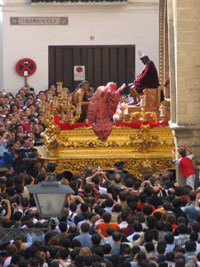 Bars and restaurants extend their hours and months of preparation by the cofradias,
or brotherhoods, of local churches comes to fruition.
Bars and restaurants extend their hours and months of preparation by the cofradias,
or brotherhoods, of local churches comes to fruition.Across the 7 days of Semana Santa more than 50 churches march through the city streets, carrying some 115 floats, or pasos, from their neighborhoods to the city center. All make their way to the Cathedral and then back to their church. Some processions routes cover many kilometers and up to 13 hours. On Thursday around midnight La Madrugá begins, with processions leaving their church shortly after, only to return on Friday morning. Tens of thousands of Sevillanos take part in the activities as nazarenos, costaleros and musicians. Others organize and prepare the floats, while local merchants and businesses work hard to feed the masses of people in the streets.
Must see:
We have spent many years in Seville during this week, both as tourists and locals. Each year offers something different, and the threat of rain always provides drama, and at times, heartbreak, canceling processions which have been meticulously planned by the brotherhoods. The most spectacular is perhaps the night from Thursday to Friday (La Madrugá), when the crowds spend most of the night and early morning hours in the streets.
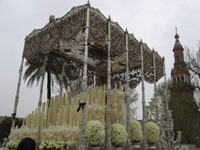 We recommend the processions of La Macarena and El Silencio.
The first one with music and La Centuria Romana (100 Roman soldiers).
The latter with only three music instruments and a more solemn procession.
We recommend the processions of La Macarena and El Silencio.
The first one with music and La Centuria Romana (100 Roman soldiers).
The latter with only three music instruments and a more solemn procession.Palm Sunday is also very popular, when Sevillanos dress their best and often start the early afternoon in Parque Maria Luisa to see the procession of La Paz pass by the Plaza de España.
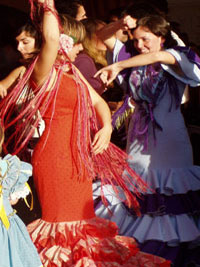 Unlike Semana Santa, the Feria de Abril takes place outside the city center, across the river on the edge of the Los Remedios neighborhood.
Months before the date a small tent city is erected along streets named for famous bullfighters.
The arch or main gate begins to take shape and brightly colored flamenco dresses experience brisk sales.
Unlike Semana Santa, the Feria de Abril takes place outside the city center, across the river on the edge of the Los Remedios neighborhood.
Months before the date a small tent city is erected along streets named for famous bullfighters.
The arch or main gate begins to take shape and brightly colored flamenco dresses experience brisk sales.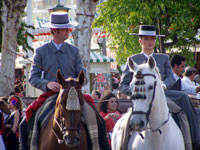 Must see:
Must see: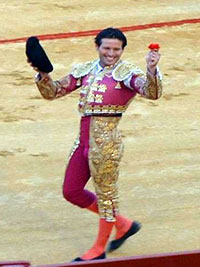 Six bulls are generally part of a bullfight, with three toreros, or bullfighters, each with the task of killing two bulls.
At the beginning all participants are introduced and in a bit of ceremony the keys are petitioned to open the doors of the bull's pen.
Once the bull is released the "fight" portion begins.
The bullfight consists of three parts, or tercios:
the first tercio involves the torero using the purple and yellow cape, or capote and the picaderos,
two men on horseback who use a spear or lance to weaken the bull.
The second part is called the suerte de banderillas in which the banderilleros have the challenge of sticking flags in the bulls back as he is charging them.
The final phase is the known as the suerte suprema, in which the bullfighter makes use of what we are accustomed to seeing - a red cape, or muleta.
After showing off his skills, he must face the bull down and kill it with his sword as it charges towards him.
If the torero does well he may be awarded the ear of the bull, which he may throw to the crowd.
Six bulls are generally part of a bullfight, with three toreros, or bullfighters, each with the task of killing two bulls.
At the beginning all participants are introduced and in a bit of ceremony the keys are petitioned to open the doors of the bull's pen.
Once the bull is released the "fight" portion begins.
The bullfight consists of three parts, or tercios:
the first tercio involves the torero using the purple and yellow cape, or capote and the picaderos,
two men on horseback who use a spear or lance to weaken the bull.
The second part is called the suerte de banderillas in which the banderilleros have the challenge of sticking flags in the bulls back as he is charging them.
The final phase is the known as the suerte suprema, in which the bullfighter makes use of what we are accustomed to seeing - a red cape, or muleta.
After showing off his skills, he must face the bull down and kill it with his sword as it charges towards him.
If the torero does well he may be awarded the ear of the bull, which he may throw to the crowd.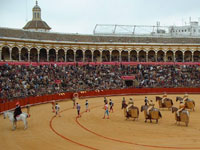 Bullfighting is an important part of the ritual of Feria de Abril, with many attending a corrida before heading to the fair grounds.
The Feria de San Miguel in September also sees some of the biggest names in bullfighting.
Keep in mind there are three types of bullfights: a corrida, which features professional fighters and larger bulls;
a novillada, in which young fighters with hopes of becoming a professional challenge;
a corrida de rejoneo, which is a fight entirely on horseback.
Bullfighting is an important part of the ritual of Feria de Abril, with many attending a corrida before heading to the fair grounds.
The Feria de San Miguel in September also sees some of the biggest names in bullfighting.
Keep in mind there are three types of bullfights: a corrida, which features professional fighters and larger bulls;
a novillada, in which young fighters with hopes of becoming a professional challenge;
a corrida de rejoneo, which is a fight entirely on horseback.
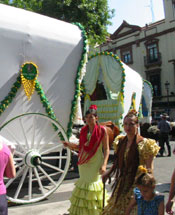 El Rocío
El Rocío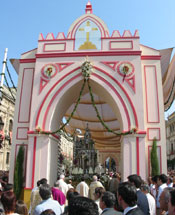 Corpus Christi
Corpus Christi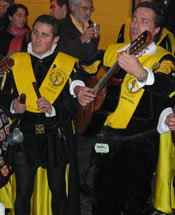 Dia de la Inmaculada (Los Tunos)
Dia de la Inmaculada (Los Tunos)